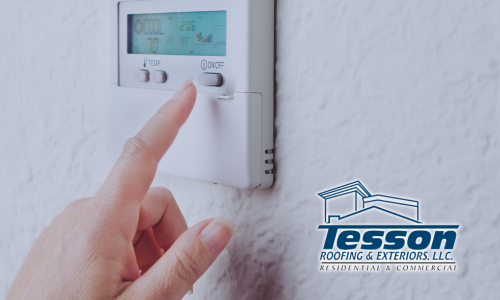Your roof serves as more than just a protective barrier against the elements—it plays a crucial role in regulating indoor temperature and enhancing energy efficiency. Understanding how your roof influences the comfort and climate control of your home or commercial building can help you make informed decisions about roof maintenance, repair, and replacement. In this blog post, Tesson Roofing delves into the mechanisms by which your roof regulates indoor temperature and offers insights into maximizing its performance for optimal comfort and energy savings.

Insulation and Thermal Barrier:
A well-insulated roof acts as a thermal barrier, preventing heat transfer between the interior and exterior of your building.
During hot summer months, proper insulation helps to keep your home cool by blocking out heat from the sun and reducing the need for air conditioning. In the winter, insulation helps to trap heat indoors, minimizing heat loss and lowering heating costs.
Ventilation and Air Circulation:
Adequate roof ventilation promotes air circulation and prevents the buildup of heat and moisture in the attic space. Proper airflow helps to regulate temperature extremes, reducing the risk of heat buildup in the summer and moisture-related issues such as mold and mildew growth. Ridge vents, soffit vents, and attic fans are examples of ventilation systems that can enhance the performance of your roof and improve indoor comfort.
Roof Color and Reflectivity:
The color and reflectivity of your roof can significantly impact its ability to regulate indoor temperature. Light-colored or reflective roofing materials, such as white or metal roofs, absorb less heat from the sun and help to keep your home cooler in hot climates. Dark-colored roofs absorb more heat and may contribute to higher indoor temperatures, particularly in sunny regions.
Roofing Materials and Thermal Properties:
Different roofing materials have varying thermal properties that affect their ability to regulate indoor temperature. Materials such as asphalt shingles, metal roofing, and clay tiles have distinct thermal conductivities and insulation values that influence their heat absorption and retention characteristics. Choosing energy-efficient roofing materials with high thermal resistance can help to optimize indoor comfort and reduce energy consumption.
Regulating Temperature Starts with the Roof and Exterior
Your roof is a powerful ally in maintaining a comfortable and energy-efficient indoor environment year-round. By understanding how your roof regulates indoor temperature through insulation, ventilation, color, and roofing materials, you can take proactive steps to maximize its performance and enhance the comfort and livability of your home or commercial building.
At Tesson Roofing, we specialize in providing comprehensive roofing services to ensure the long-term health and performance of your roof. Whether you’re in need of roof inspection, repair, or replacement, our team of experts is here to help.
